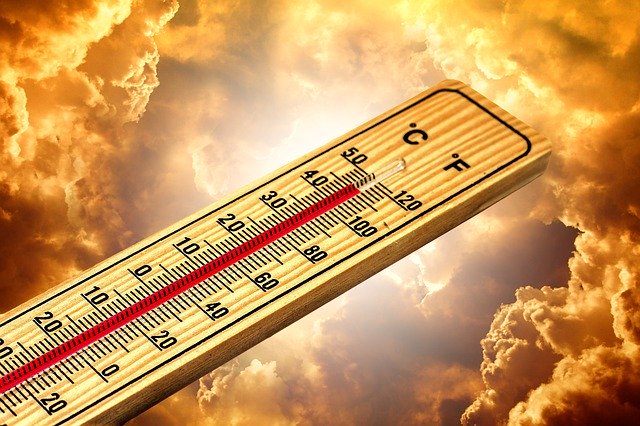Don’t miss the signs of heat exhaustion and heat stroke in your patients being seen in sick call or as emergencies, especially in the hot weather months. Here is a review of the symptoms and treatment*.
It’s that time of year again- summer – when heat-related illness, such as heat exhaustion and heat stroke should be on our minds when evaluating vague patient symptoms; especially when the weather is both hot and humid, like many of our southern states. In addition, some of our older facilities lack air conditioning in every unit (hopefully the health unit DOES have it). So, how can you identify and treat heat injuries?

Vulnerable Conditions
Although anyone can succumb to heat and humidity, the young and old have fewer reserves to overcome heat stress. If possible, move patients with the following conditions to special housing or provide with additional monitoring and fluids during high heat alerts.
- Elderly
- Heart disease
- Pulmonary disease
- Mental illness
A main reason those with the above conditions are prone to heat-related illness is the medication they are likely prescribed. The following medications or substances increase heat-related illness risk.
- Anticholinergics (Atrovent, Chlor-Trimeton, Cogentin, Spiriva)
- Antihistamines (Allegra, Benadryl, Zyrtec)
- Benzodiazepines (Klonopin, Librium, Valium, Xanax)
- Beta blockers (Atenolol, Corgard, Lopressor)
- Calcium channel blockers (Cardizem, Norvasc, Procardia)
- Diuretics (Chlorothalidone, Diuril, Lasix)
- Neuroleptics/Phenothiazines (Haldol, Mellaril, Prolixin)
- Tricyclic antidepressants (Pamelor, Tofranil, Vivactil)
Rapid Cooling and Hydration for Heat Injury
Heat exhaustion and heat stroke are the two most common heat injuries, although sunburn and heat cramps are also often listed. In heat exhaustion, the body decompensates due to its difficulty maintaining normal body temperature in an extended high heat situation. Heat stroke begins when the body becomes unable to keep internal temperatures in a livable range. Without intervention, heat exhaustion can progress to life-threatening heat stroke. Here is a quick comparison of the presentation and treatment of heat exhaustion and stroke.
Heat Exhaustion Presentation
- Body temperature under 104 degrees F
- Cold, clammy skin
- Muscle and stomach cramps
- Thirst
- Tachycardia
- Ataxia (unsteady gait)
- Headache
- Nausea or vomiting
- Tiredness, weakness
- Dizziness and fainting
Heat Stroke Presentation
- Body temperature above 104 degrees F
- Hot, dry skin or may have profuse diaphoresis
- Severe headache
- Confusion, strange behavior, seizures, or unconsciousness
- Tachycardia
- Hypotension
- Hyperventilation
As you can see, many of the symptoms are similar, because heat stroke is an intensification of heat exhaustion. Differentiating factors include confused mental status and hypotension. In both cases, treatment focuses on rapidly cooling and hydrating the body. Heat stoke definitely requires hospitalization, while heat exhaustion, if mild, may be treated at the facility with infirmary monitoring. In all cases, consult with the facility provider to determine the best course of treatment for the patient you suspect has a heat-related illness.
Heat Exhaustion Treatment
- Move to a cool area (Shade, AC)
- Remove or loosen restrictive clothing
- Rehydrate with fluids
- Use evaporation methods
- Spraying water on the body and fan the air
- Sponge body with cool water
- Rest
- Monitor until body temperature returns to normal and other symptoms have ceased.
Heat Stroke Treatment
- Move to a cool area (shade, AC)
- Removal of restrictive clothing
- Use evaporation methods
- Spraying water on the body and fan the air
- Sponge body with cool water
- Covering the patient with cold water–soaked sheets
- Place ice packs in the axillae and groin
- Supplemental oxygen, if available
- Prepare for possible initiation of IV therapy
- Prepare for transfer to acute care
Patient Education for Prevention
Helping patients to manage heat and humidity can prevent heat injury. These reminders are important for officers and healthcare staff, as well.
- Keep hydrated. This can be difficult where bad-tasting water and fruit-flavored Kool-Aid are the only options. Advocate for healthy fluid options for your patients when possible. Ask about fluid intake during your subjective assessments.
- Reducing physical exertion. Now is not the time for basketball competitions or lifting challenges. Many inmates are on outdoor work duty with many hours in the sun. Be mindful of the work status of inmates coming to sick call with symptoms of dizziness, weakness, headache, and general body tiredness. Instruct patients to take frequent rest breaks and seek out shaded areas at work sites and recreation areas.
- Use available cooling methods. Teach patients evaporation heat reduction methods to stay cool such as sponging body areas with cool water and body fanning.
Personal Safety in the Heat
Don’t forget yourself in your summer heat preparations. You are also vulnerable to heat injury. Even if the medical unit is air conditioned, many health care activities take place outdoors or in housing units. Be sure to follow all the instructions provided to patients. Stay hydrated and monitor your mental and physical status regularly. Urine output and characteristics can be a good indication of adequate hydration. If you are basically healthy, pale urine is an indication of appropriate bodily fluid volume and generally good kidney function. Concentrated darker urine or decreased urine output can indicate a need to increased fluids. Double up on the fluids you bring on shift. Water is always a better option than sweet or caffeinated drinks.
*As always, your company or facility policies, procedures and Nursing Protocols/Guidelines take precedence over any written recommendations on this website.
Do you work in a high-heat setting? How do you keep your cool and manage your patient’s heat regulation during the summer? Share your thoughts in the comments section of this post.
Leave a Reply